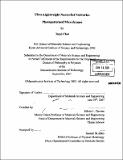Ultra-lightweight nanorelief networks : photopatterned microframes
Author(s)
Choi, Taeyi
DownloadFull printable version (39.13Mb)
Other Contributors
Massachusetts Institute of Technology. Dept. of Materials Science and Engineering.
Advisor
Edwin . Thomas.
Terms of use
Metadata
Show full item recordAbstract
Lightweight nano-network structures in polymers have been fabricated and investigated for their mechanical properties. Fabrication techniques via holographic interference lithography and phase mask lithography were implemented for periodic and quasiperiodic bicontinuous polymer-air structures on the submicrometer length scale. For 3D quasiperiodically nanostructured materials, quasicrystalline phase mask lithography utilizing 2D quasiperiodic phase mask was successfully employed. 2D hexagonal arrays of air cylinders in SU8 polymer films and 3D four-beam connected (3- R3m ) and octagonal quasicrystalline SU8 films were fabricated and analyzed in this thesis. For investigating the mechanical properties of various nano-network structures, three different methods of mechanical characterization were applied. Atomic force microscopy with its nanometer scale resolution was adopted to conduct force measurements to probe local elastic properties of the sample. Templated by the light intensity distribution from three-beam interference, the spatial distribution of elastic modulus was observed in the pattern of 2D hexagonal air-cylinder and a uniform SU8 polymer film by AFM nanoindentation. A second method for mechanical characterization, the microtensile tester enabled us to evaluate a symmetry effect on the elastic and plastic properties of the polymer fibers and thin films. Large plastic deformation of 200nm-diameter struts comprising the 3D periodic and quasiperiodic microframes of the normal brittle bulk polymer was discovered and is an example of length-scale dependent mechanical behavior. Crack propagation and energy absorption were guided along the symmetry directions in the periodic structures. However, there was found no preferred direction of crack propagation in quasicrystalline nanostructures due to the absence of translational symmetry. (cont.) The third method, Brillouin light scattering (BLS) allowed estimation of the phonon properties in the structured films and the associated mechanical properties. The BLS measurements also confirmed the isotropy of modulus with the symmetry of the structures. The length scale dependence, the effect of structural symmetry and the processing dependence of the mechanical behavior of the various nanostructures in SU8 polymer films were observed. The hundred-nanometer length scale of 3D nanostructures induces plastic deformation of struts under an applied force, which makes the film tougher and energy absorbing. The symmetry of the structured films determines the preferred direction of crack propagation and following fracture behavior. Octagonal-patterned (8mm) quasicrystalline films via quasicrystalline phase mask lithography (QCPML) exhibit higher specific toughness and fracture strength with the unit mass than uniform solid films.
Description
Thesis (Ph. D.)--Massachusetts Institute of Technology, Dept. of Materials Science and Engineering, 2007. Includes bibliographical references.
Date issued
2007Department
Massachusetts Institute of Technology. Department of Materials Science and EngineeringPublisher
Massachusetts Institute of Technology
Keywords
Materials Science and Engineering.